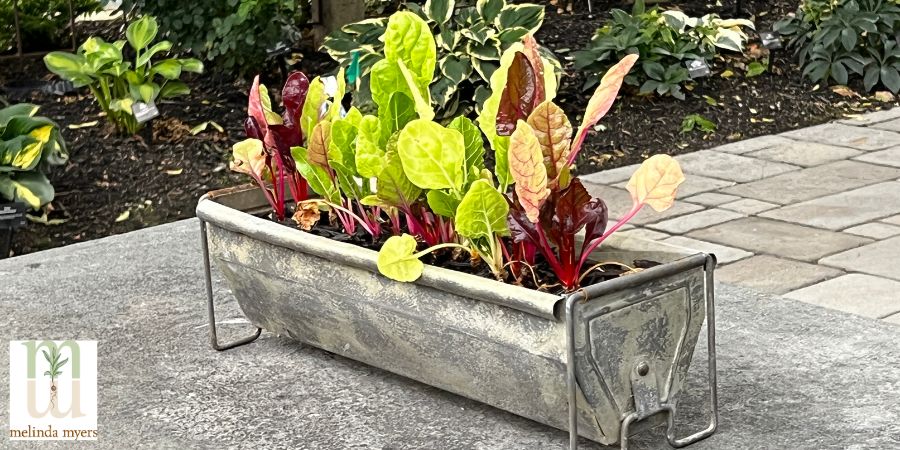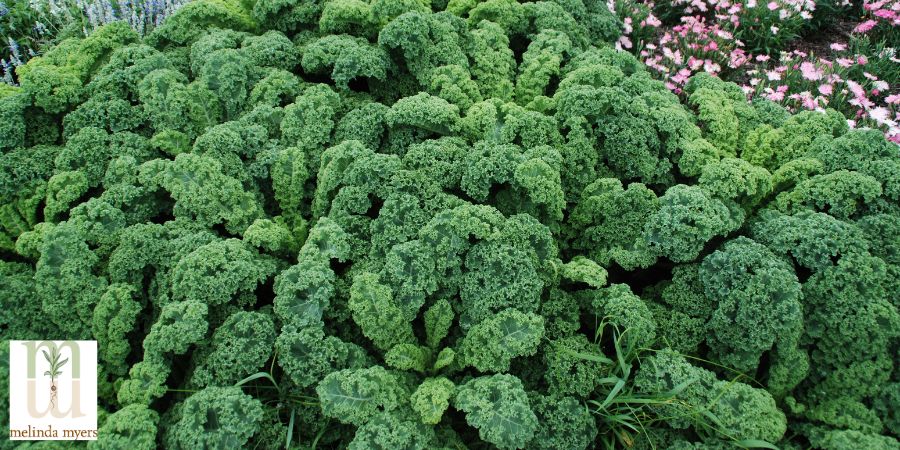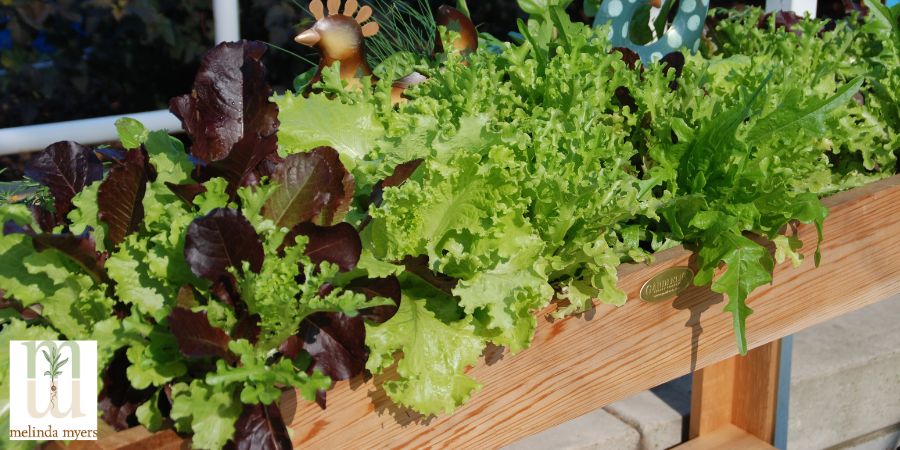Growing Your Own Salad
- horticulturist and gardening expertApril 11, 2023
Grow your own salad greens for the best flavor and greatest nutritional value. Fortunately, you don’t need a lot of space to grow them. A small spot in the garden, an elevated garden, or a container will do just fine.
I grow my greens in an elevated garden on my patio. This provides easy access, so I am sure to harvest and use them regularly. It also keeps them out of the reach of hungry rabbits.
Selecting Greens to Grow for Salad
You will find a wide range of greens from various plant families. Lettuce, chicory, and dandelions belong to the Aster family, along with sunflowers, asters, coneflowers, and zinnias. Spinach, Swiss chard, and orache are relatives of amaranth plants that are grown for food or ornamental value. The spicy and strong flavors of arugula, kale, and mustard greens are reminiscent of their cabbage, broccoli, and Brussels sprouts relatives.

Swiss Chard
Greens are generally easy to grow if planted at the right time of the year. Most produce best during the cooler months of the year. That means planting and harvesting in spring and fall for most of us and winter for our southern gardening friends.
As summer temperatures rise, lettuce, spinach, and other cool-weather greens bolt, sending up flower stalks, and the flavor usually deteriorates. Remove the plants or leave the lettuce seeds for the birds to eat. Mask their unsightly appearance by planting cosmos seeds along with lettuce. The cosmos will mask the declining lettuce plants and attract bees, butterflies, and birds to the garden.
There are a few greens that are more heat tolerant and will grow for many of us throughout the summer. Black-seeded Simpson, oakleaf, red sails, and sandy are a few leaf lettuce cultivars that stand up to the summer heat. Select sunland, coastal star, Monte Carlo, and other Romaine lettuces noted for their heat tolerance.
Malabar spinach is not a true spinach but has a buttery, nutty spinach-like flavor. This attractive vine thrives in the heat of the summer and can be grown in the garden or container and trained onto a support. Use the leaves fresh as a wrap for sandwiches or in stir fry.
New Zealand spinach is another plant that shares the common name and flavor but is not a true spinach. Eat the small leaves raw or cooked.
Many of the mustards, like Red Giant and Florida Broadleaf will tolerate summer heat while adding a bit of zip to your salads. Or try the mild-flavored All-America Selections winner Red Kingdom Mizuna, a Japanese mustard. Use mustard greens pickled, raw, wilted, or in salads.
Swiss chard, kale, and orache are a few more heat-tolerant greens. Orache prefers cooler temperatures but does not go to seed as quickly as spinach. Harvest young leaves for the best spinach-like flavor.
Healthiest Greens to Grow
Salad greens are low in calories and generally provide lots of vitamins, minerals, and fiber. Spinach, kale, romaine lettuce, watercress, Swiss chard, and arugula are some of the most nutritious. Compare their nutrient and fiber content and learn more ways to get the most bang for the bite from Harvard Medical School.

Kale
The popular iceberg lettuce has a mild flavor that some reluctant salad eaters prefer. It does contain some folate and vitamin A, but is not nutrient dense. Consider boosting the nutrient value of iceberg lettuce salads by mixing in some of the more nutritious greens. You may soon find you need less iceberg lettuce and prefer more of the nutritious greens in your salads.
Start with some of the milder yet more nutritious greens like Romaine. I am not a fan of kale and Swiss chard but do like the milder flavors of baby leaf kale and baby Swiss chard. Your family may as well.
You will need about two cups of salad greens to match the nutritional value of one cup of most vegetables. I see this as an advantage, allowing me to fill my plate with lots of low-calorie greens. Just limit the salad dressing and croutons if you are trying to manage your weight.
How to Grow Salad Greens
Check the seed packet for the best time to grow the various salad greens in your location. The packet should also provide tips on planting depth, spacing, preferred growing conditions, and harvesting tips for the greatest productivity. Greens take anywhere from 40 to 70 days before they are ready to harvest. The type of green and weather conditions will influence timing.
Most salad greens thrive in cooler temperatures of 50 to 75 degrees. They prefer full sun, but most will tolerate some shade. A bit of mid-day or afternoon shade can help keep the plants a bit cooler, extending the harvest time a bit longer as temperatures rise.
Jumpstart the season by planting a container of greens. Move it outside when conditions are suitable and back indoors when severe weather is in the forecast. Or cover plantings with floating row covers that allow air, light, and water through while protecting plants from cold weather. These also prevent birds from harvesting the seeds and dining on young seedlings.
Prepare the soil in the garden before planting. Adding compost will help improve drainage in heavy clay soils and increase the water-holding ability of sandy soils. It also promotes healthy growth and greater productivity. This is also a good time to incorporate Milorganite, labeled for use on edible plants. It is a low nitrogen slow, release fertilizer providing weeks of nutrients, eliminating the need for weekly fertilizer application.
Select a quality potting mix when growing greens in containers and elevated gardens. Adding Milorganite at planting will help reduce the maintenance of contained gardens.

Lettuce
A second application may be needed in six to eight weeks or when planting a second crop for a fall harvest. Timing depends on the weather and your soil. Let plant growth and growing season be your guide. Fortunately, Milorganite will not burn plants if the weather does turn hot and dry.
Water thoroughly and often enough to keep the soil moist but not soggy wet. Check containers daily, as these tend to dry out more quickly than your garden soil.
Once the seedling forms two sets of true leaves, these look like the leaves of mature plants; you will need to do a bit of thinning. Check the seed packet and remove enough seedlings so those remaining are at the proper distance apart. This allows those plants to reach full size for maximum productivity. Use the seedlings you removed for salads, sandwiches, or snacks.
Leaf lettuces can be harvested when the leaves are four to six inches tall. Harvest just the outer leaves of those referred to as “cut-and-come-again”. They will keep producing new leaves for ongoing harvests.
If your season allows, consider making several plantings a couple of weeks apart. Check the seed packet for the number of days to harvest. Make sure the plants have sufficient time to reach maturity before hot or cold weather arrives and damages the plants.
Harvest greens in the morning or early evening, if possible, when the plants are full of moisture. I like to harvest just what I need, as freshly picked greens taste best and have the maximum nutritional value. This is a big advantage of growing your own, as many greens have a short storage life.
Cleaning greens can be a challenge. I recently heard a chef interviewed on Public Radio share her tip for cleaning greens. She places them in the salad spinner and fills the bowl with water. Next, she gently agitates the greens to dislodge any soil. The greens are drained in the colander part of the spinner. Repeat if needed, then use the spinner to dry the greens before making your salad.
How to Grow Healthy Salad Toppings
Spruce up your salads with some other homegrown favorites. Add some flavor, color, and crunch with carrots, beets, and radishes. These can be grown in the garden or in containers. Use short and half-long carrots when growing pots or heavy soil.
Add some sweet peppers and cherry tomatoes to your salads, gardens, and containers. These plants thrive in full sun and the same soil as greens. Grow individual plants in their own container for maximum productivity. Or use them as a vertical accent in mixed container gardens.
Dress up your salads with some edible flowers like pansies and calendula. Make sure they have not been treated with a pesticide, and remove the reproductive parts that are often bitter. I find this elevates my salads to a gourmet level. Just tell family and guests they are edible or you will end up with a pile of flowers on the edge of the plate. Gradually introduce edible flowers, like any new food, into your meals and monitor for allergic reactions.
Including greens in your garden and containers is an easy way to boost the flavor and nutrition of your family meals.

